What in the world is she talking about, you might ask? But if you’re a chair caner, I bet you already know what I’m talking about, right? In this post, I will help you decide which hole to use for the fish head to complete the pattern correctly.
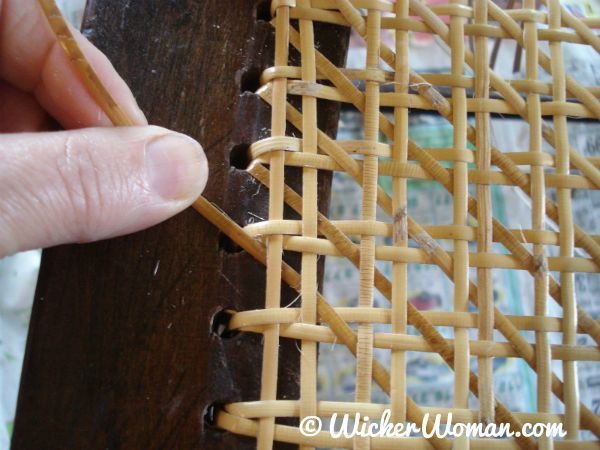
How to choose the right hole to use for the fish head
Whenever you are weaving a traditional hole-to-hole cane chair seat, there will be times when it’s up to the weaver to decide what drilled holes to skip and what holes to double up on and put the diagonal “fish heads” in. Whaaaat???

If you are unfamiliar with the term, “fish heads” they are created when two parallel diagonal strands go into the same drilled hole. When the two strands are in the hole, it looks like the profile of a fish’s head, so that’s where the term came from.
Fish heads are placed in every drilled corner hole on a square, rectangle, or trapezoid seat, several places around the curves of a round chair seat, and in many places along the four rails of a trapezoidal seat.
These fish heads are positioned this way to maintain the “X” pattern created by the next diagonal row. You, as the weaver, need to determine what hole to put these first diagonal strands in to make that happen.
Then, when you weave the second set of diagonals down the side, front, or back rails to complete the pattern of “Xs.”

Then, as you finish weaving this diagonal and apply the second one, going in the opposite direction, the “Xs” will take form all the way down the rail and you’ll have the fish head in the corner hole, like in the picture below.

Look closely at the horseshoe-shaped chair seat below and identify the fish heads in each corner hole as well as several on each of the four rails.
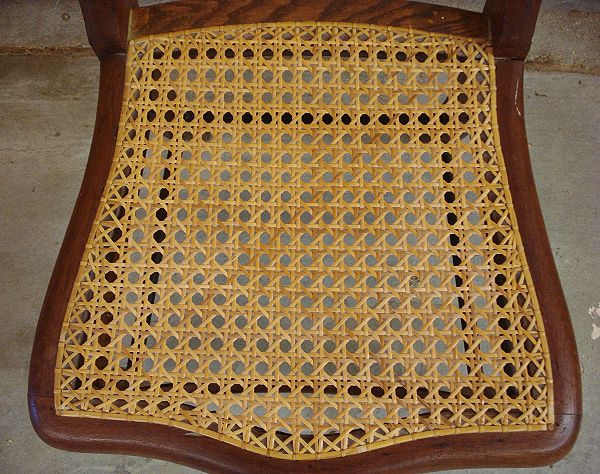
Be sure to visit my Chair Caning Instructions page for complete directions on how to weave cane seats and also get hints and tips for making all those fish heads and Xs easy!

What are your thoughts about this blog post?
Leave your comments below and share with your social networks!
~~Live Well, Laugh Often, Love Much ~~
Happy Weaving, until next time!



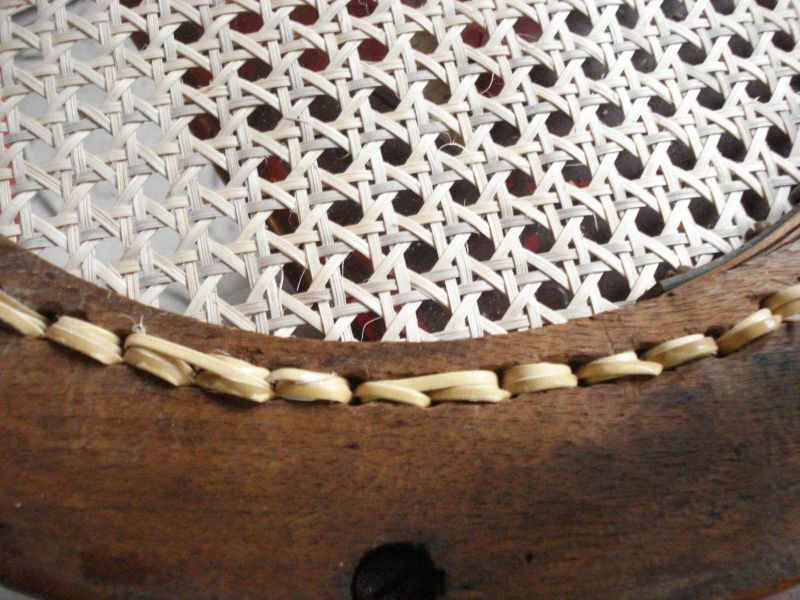
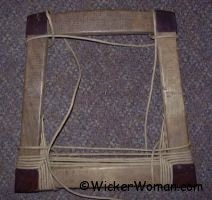
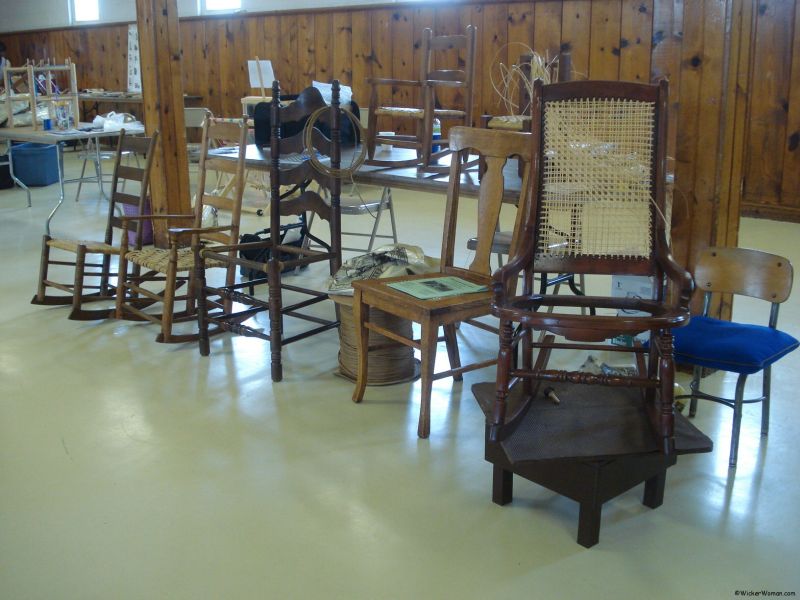
if I have a chair seat to chane with 37 holes on the front and 32 holes on the side how to center so as to get a perfect “X” while doing diagonally and which are the holes that i could skip or double to get it perfect?
Hello Rohan,
The easy way to determine the center of the cane seat is to find the center hole on the back rail and then the center hole on the front rail. Put a peg in each one and then start caning by putting the tail of your weaver in the back center hole and weave toward the center hole on the front rail.
Put in those foundation strands all the way across the right side first, then repeat on the left side. Setting up the foundation strands in this manner makes certain that you will have parallel vertical lines for the rest of the chair seat.
For the complete instructions with videos, hints and tips, go to my Chair Caning Instructions page. Good luck, glad to help you out!
Hi Cathryn,
I need to know how big the hole in the chair itself needs to be to allow
for four strands of cane to go into!! Is there a general size??
Hi Anne,
I’m not sure what you are asking here. Are you building a chair and need to know the dimensions of the drilled holes in the perimeter? And when you are weaving with strand cane in chairs that already have the drilled holes in them, you adjust the size or gauge of cane strands to the diameter of the drilled holes.
The larger the drilled holes are, the larger cane size you will use and then vice versa. Small holes get tiny gauge cane. Please refer to my Chair Caning Instructions page for help in determining what size or gauge of cane to use for the size of the drilled holes.
Keep in mind that with almost all hole cane chairs there will be far more than four strands going into each hole. Most holes have at least 6-8 strands of cane in them and with certain designs and patterns, there are even more going into each hole.
Good luck on the project! And let me know how it turns out!
Anne,
You can go to my Chair Caning Instructions page and look at the table I have posted there which lists the size of the drilled holes, the distance from center hole to center hole and then the accompanying gauge/size cane that should be used. Or you can use the “quick and dirty” measuring method too, that I show in the instructions. Also, each one of the suppliers have a table in their catalogs showing the measurements too and if you still have questions, give them a call.
I guess that finding the correct hole for the short settings/weavings is what I spend most time deliberating. They always seem to need to go one or two holes further up than I think. If they are right, then the fish heads will go in the hole beneath and there won’t be the problem of the shorts bending too much and it also eliminates the wide bit of ‘settingless’ Xs above the shorts.
Thanks for the comments about the fish heads Sue, appreciate your thoughts and techniques! Always enjoy the discussions on various ways of weaving and hearing the reasons for those actions. We all learn so much from the interaction.
The fish heads ALWAYS go in the hole ‘neath the short vertical (setting) or horizontal (weaving). Unless it is really impossible – and I mean really impossible. If you don’t do this you will get uneven gaps around the edge.
And Xs (kisses) why, oh why can’t I get people to understand this concept.
The diagonal always crosses the first pair of strands that are going down the hole before it is allowed to go down the next one. If you don’t do this and end up with ^^^ the first row of horizontals will move around and look messy.
Sue, thanks so much for your comment on making the fish heads and the “Xs,” it’s always nice to hear what techniques other weavers are using and find helpful don’t you think?
I do have to take issue with your comment about the fish heads “always” going beneath the short vertical row however. Although that is my practice too, in most cases.
As in the picture here, it was impossible for me to do that because there wasn’t enough space on the rail and the vertical row, and there was way too much of a curve when I did try to lay that diagonal strand into that hole.
So that’s why I waited and put the fish head (two diagonals) into the third or fourth hole down. And then of course, I repeated the exact same pattern on the other side of the chair seat to keep it all symmetrical.
I’m probably one of those not doing this correctly. I have some difficulty visualizing where the problem arises in the first photo. Looking forward to further blogs or video.
Ohhhhh THANK YOU, Cathryn !!!!! I hope everyone who does this WRONG will see why it needs to be done THIS way, and this way ONLY ! So many chairs—so little time !
Welcome Jan, I will be making a more in-depth post on making the “Xs” soon, too.